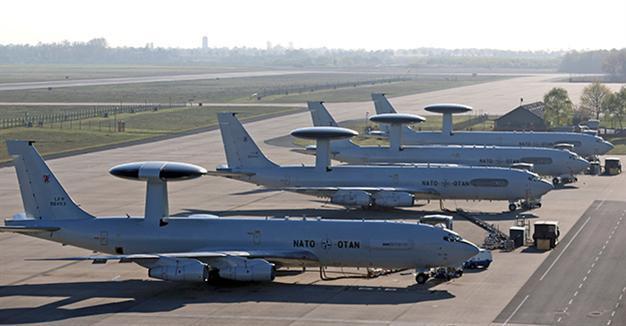NATO begins periodic surveillance of Turkish airspace
ANKARA

NATO AWACS (Airborne Warning and Control Systems) aircrafts are seen on the tarmac at the AWACS air base in Geilenkirchen, near the German-Dutch border in this April 16, 2014 file photo. REUTERS Photo
The Turkish General Staff has announced that a NATO Boeing E-3A Sentry Airborne Warning & Control System (AWACS) aircraft has begun surveillance in Turkish airspace as part of assurance measures for Turkey, while noting that NATO’s mission would be conducted “periodically” in the coming months.
“In line with the Syria crisis and developments taking place in the region and within the content of reassurance measures for Turkey, a NATO AWACS plane has begun conducting [surveillance] duty in Turkish airspace from March 12 to March 15,” the General Staff said in a written statement posted on its official website late on March 12.
“These duties are planned to be conducted regularly and within certain periods in the coming months too,” the General Staff added.
In December, after tensions flared between Turkey and Russia, the U.S and other NATO allies decided on a package of assurance measures for NATO member Turkey in view of the volatile situation in the region. Alongside an increased AWACS presence, the package also included an increased naval presence in the eastern Mediterranean Sea.
“We agreed with Turkey on Feb. 11 to intensify [and] to increase surveillance of [the] border between Turkey and Syria. We are in the process of establishing [this] with Turkey in the best possible way,” NATO Secretary General Jens Stoltenberg told a joint news conference with European Commission President Jean-Claude Juncker in Brussels on March 10.
NATO’s ongoing mission in Turkish airspace is being conducted within the framework of the alliance’s main duty of collective defense and of the principle of indivisible security of the alliance, the Turkish General Staff said. The mission aimed at “displaying NATO’S support to Turkey and the alliance’s unity and solidarity and providing deterrence vis-à-vis potential hostile threats against the alliance’s territorial integrity,” it said.
On March 8, two civilians, including one child, were killed in southern Turkey when several rockets from Syria hit the Turkish town of Kilis.
NATO had already agreed to send vessels to the Aegean Sea in an attempt to crack down on human smugglers and stem the flow of refugees seeking to enter Europe via Greece. This would allow NATO vessels to be present in both Greek and Turkish territorial waters.
NATO launched the deployment, the first civilian operation of its kind for the military alliance, after a request by Greece, Turkey and Germany to help tackle Europe’s biggest migration crisis since World War II.
More than one million people have crossed the Mediterranean since the start of 2015, including many refugees fleeing the war in Syria.
